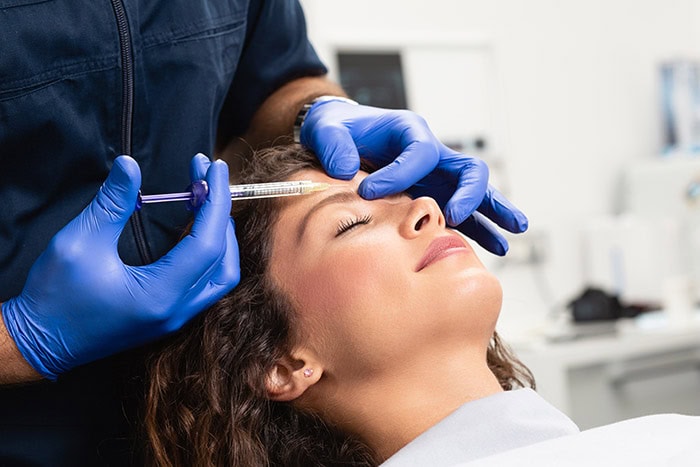Understanding Botox and Possible Side Effects
Botox anti-wrinkle injections are one of the most popular non-surgical treatments for softening lines and wrinkles, with millions of procedures performed safely every year. While most patients experience no problems at all, some do report a mild headache after treatment.
This usually settles quickly, but it can be worrying if you don’t know what to expect.
In my Wimbledon cosmetic clinic patients from Raynes Park, Kingston, Surbiton, Richmond, and across South West London often ask me whether headaches are a normal side effect, how long they last, and if there’s anything to be concerned about. In this article, I’ll answer the most common questions about Botox and headaches — including when Botox can actually help with migraines.
Why Is Botox Giving Me a Headache?
A mild headache is sometimes reported in the first 24–48 hours after Botox treatment. While most patients experience no discomfort at all, it can happen occasionally and is usually short-lived. The exact cause isn’t fully understood, but possible reasons include:
- Slight tension in the muscles as they begin adjusting to the effects of Botox
- Minor inflammation or sensitivity at the injection sites
- Stress or dehydration around the time of treatment, which can make headaches more noticeable
- Temporary nerve irritation in rare cases, as the body responds to the injections
These headaches are generally mild, temporary, and settle quickly. Many patients find they respond well to simple self-care such as staying hydrated, resting, and using paracetamol if needed. It’s very uncommon for Botox-related headaches to persist beyond a couple of days.
Understanding how Botox works on the muscles and nerves can also make these side effects feel less worrying. If you’re curious, my article on the science behind anti-wrinkle injections explains the process in more detail.

A mild headache can be a short-term, common side effect of Botox, usually settling within a day or two.
Is It Normal to Get a Headache After Botox?
Yes — mild headaches can be a normal short-term side effect of Botox, though not everyone experiences them. Most patients find they pass within a day or two and do not interfere with daily activities.
Headaches after Botox are not dangerous and are actually much less common than other mild side effects such as small bruises, slight swelling, or redness at the injection sites. They are thought to occur as your muscles adjust to the treatment or due to temporary sensitivity in the treated area.
If your headache persists longer than 48 hours, feels severe, or is accompanied by other unusual symptoms, it’s always best to check in with your practitioner for reassurance and advice.
What Are the Three Common Side Effects of Botox?
The three most common minor side effects of Botox are:
- Redness or swelling at the injection points – this usually appears within the first few hours and fades quickly as the skin settles.
- Mild bruising in the treated area – tiny blood vessels under the skin can occasionally be affected by the needle, leading to small bruises. These are harmless and tend to resolve within a few days.
- Headache or a heavy feeling in the forehead – some patients notice a mild ache or tightness as the muscles adjust to treatment, but this is short-lived.
All of these effects are temporary and self-limiting, typically resolving on their own within a few days without the need for medical treatment.
Serious side effects are very rare when Botox is carried out by a qualified, experienced medical practitioner in a safe clinical environment. Choosing the right provider is one of the best ways to ensure your treatment is both safe and effective.
Can Botox Trigger or Relieve Headaches?
Interestingly, Botox can do both. While a few people may experience a short-lived headache after cosmetic treatment, Botox is also a licensed medical treatment for chronic migraines.
In fact, regular Botox injections into specific head and neck muscles can reduce the frequency and severity of migraines in many patients. So while headaches are occasionally a side effect in the short term, they can also be one of the conditions Botox helps treat long term.
If you are currently breastfeeding and considering treatment, it’s important to weigh up all the safety aspects carefully – I discuss this in detail in my guide to Botox and breastfeeding.
What Is the 2cm Rule for Botox?
The “2cm rule” refers to the safety guideline when treating frown lines. Botox should be injected at least 2cm above the eyebrow to avoid affecting the wrong muscles, which could cause drooping of the eyelid.
When injections are placed carefully and correctly, the risk of unwanted effects (including headaches caused by tension in the wrong muscles) is greatly reduced. This is why choosing an experienced injector is so important.

The 2cm rule helps ensure Botox for frown lines is placed safely above the eyebrow, reducing the risk of eyelid drooping.
What Are the Signs of Too Much Botox?
Headaches are not usually a sign of “too much Botox.” Instead, they are a short-term side effect that some patients experience as their muscles adjust.
Signs that too much Botox may have been used include:
- An overly frozen or stiff appearance – where facial expressions look limited or unnatural.
- Eyelid or eyebrow drooping – caused by Botox spreading into the wrong muscles or excessive dosing in the forehead.
- Difficulty making natural facial expressions – for example, struggling to raise your eyebrows or smile as you normally would.
The good news is that these effects are temporary. As Botox gradually wears off over several weeks to months, movement and expressions will return. However, these issues highlight the importance of choosing an experienced, medically trained practitioner who understands correct dosing and placement to achieve subtle, natural results.
So short-term side effects like mild headache don’t mean Botox is dangerous, but they are important to discuss with your practitioner. For a broader perspective, I’ve written a separate guide on whether Botox is safe long-term.
Additional Questions People Ask
How Long Do Botox Headaches Last?
Most headaches after Botox resolve within 24–48 hours and are mild enough to manage with rest or paracetamol. If a headache lasts longer than two days or feels unusually severe, it’s best to contact your practitioner for reassurance and further advice.
How Can I Prevent a Headache After Botox?
Gentle aftercare can make a big difference to how you feel in the first couple of days. Following simple Botox aftercare advice helps minimise bruising, swelling, and discomfort, including mild headaches.
You can reduce the risk of a headache by staying well-hydrated before and after treatment and avoiding alcohol for at least 24 hours. Following aftercare guidance — such as skipping strenuous exercise, saunas, or hot showers in the first day — also helps minimise discomfort.
Should I Take Painkillers for a Botox Headache?
Yes, paracetamol is safe to use if you feel uncomfortable after treatment. It’s better to avoid ibuprofen, aspirin, or other blood-thinning painkillers unless prescribed, as these may increase the risk of bruising around injection sites.

Paracetamol is safe for relieving a mild Botox headache — avoid aspirin or ibuprofen unless prescribed.
Final Thoughts
A mild headache after Botox is not uncommon and usually passes quickly. In some cases, Botox treatment can actually help with chronic headaches and migraines. The key is careful technique, the right dosage, and proper aftercare.
Headaches are usually a short-term side effect rather than a sign of deeper harm, but it’s still sensible to think about the bigger picture. For a wider view, you can read my article on whether Botox is safe long-term.
📍 If you’re considering Botox in Wimbledon, Raynes Park, Kingston, Surbiton, Putney, or anywhere in South West London, I’d be happy to guide you through safe aftercare and treatment plans tailored to your lifestyle.
If your goal is a subtle, refreshed appearance, we’ll also discuss doses, treatment areas, and how often to repeat treatment so your results stay soft and natural. You can read more about my approach in my guide to getting a natural look with Botox.
During your free consultation, we’ll discuss your skin concerns, assess your facial structure, and decide together which treatment aligns best with your needs.
Book your free consultation here →
Or call me directly: 07702 389 636
Warm regards,
Dr Suresh Mohan
Contact Dr Suresh Mohan
Considering Book FREE consultation! My clinic is dedicated to providing this advanced skin rejuvenation technique, ensuring top-notch care in the heart of London.
If you have a specific question, want to book a free consultation or request a call back, please fill in the form below, and I will get back to you as soon as possible.
By clicking ‘Send enquiry‘ you agree to Dr Mohan Clinic’s Privacy Notice.







